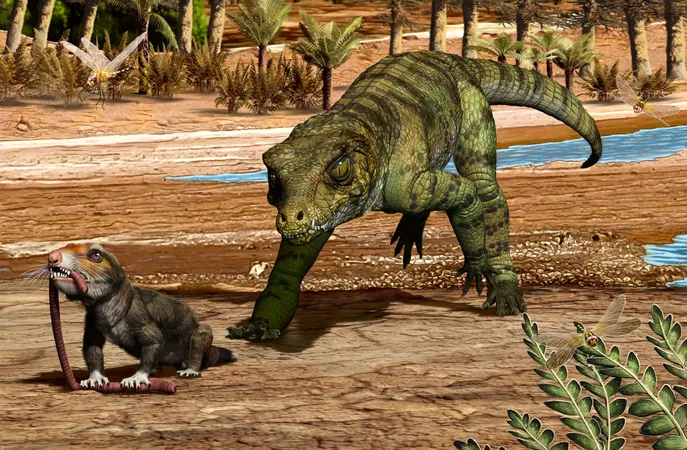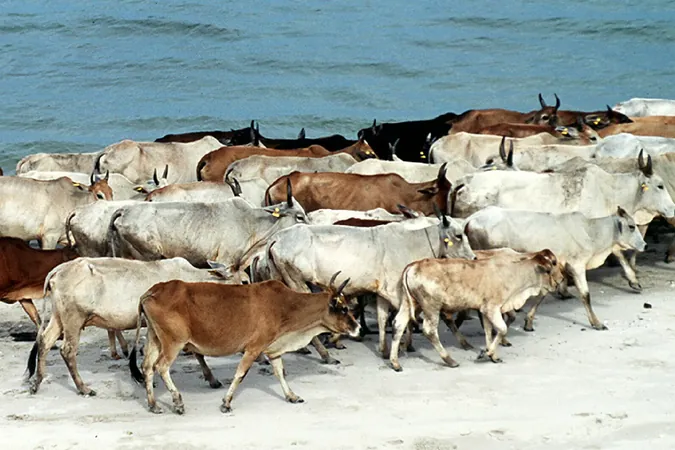
Unveiled Secrets: How Crocodiles Outlasted Two Mass Extinctions!
2025-04-16
Author: Jia
Crocodiles: The Longevity Kings of Evolution
For ages, crocodilians have been dubbed "living fossils"—unchanging remnants of an ancient world. However, groundbreaking research from the University of Central Oklahoma and the University of Utah unveils a different narrative: these reptiles boast a surprisingly adaptive and resilient evolutionary history.
Spanning over 230 million years, crocodilians, which include today’s crocodiles, alligators, and gharials, have admirably survived two significant mass extinction events. Their evolutionary success allows them to thrive in the world’s murkiest environments, but there's more to their story than meets the eye.
The Secret to Their Endurance
In a recent study, researchers pinpointed that a key factor in the crocodilian survival saga is their astounding dietary flexibility and adaptability to various habitats.
Lead author Keegan Melstrom emphasizes, "While many evolutionary cousins of crocodilians displayed greater diversity and ecological roles, they ultimately vanished. Only a handful of adaptable crocodylomorphs remain today—what's their secret?"
Mass Extinctions: A Dual Narrative of Survival
Earth has weathered five mass extinction events, with experts warning of a potential sixth driven by human activity—habitat loss, climate change, and invasive species might be tipping points for many species. Studying traits that enhance survival during these times could be crucial for modern conservation efforts.
While mammals have often taken the spotlight in extinction survival discussions, crocodilians have been largely overlooked. This newly published research in the journal Palaeontology highlights the unique dietary ecologies of crocodylomorphs that enabled them to endure not one, but two cataclysmic events: the end-Triassic around 201.4 million years ago and the end-Cretaceous about 66 million years ago.
Unmasking the Ecological Diversity of Crocodilians
Today's crocodilians are renowned for their semi-aquatic predatory lifestyle. Interestingly, when examining the fossil record, researchers discovered a vibrant history of diverse dietary practices among ancient crocodylomorphs.
In the Late Triassic Period, early crocodylomorphs were carnivorous and often rare, while many other pseudosuchian groups held various ecological roles. As history unfolded, it was notably the adaptable terrestrial generalists among crocodylomorphs that survived the catastrophic end-Triassic extinction, while other more specialized species became extinct.
Melstrom adds, "Post-extinction, crocodylomorphs exploded into a multitude of ecological roles—from aquatic predators to terrestrial herbivores, showcasing a remarkable evolutionary flexibility.”
Unearthing Ancient Diets: A Monumental Task
So, how do scientists piece together the diet of these ancient reptiles? Through detailed analysis of fossilized teeth and skull shapes, researchers are able to infer the dietary habits of long-gone species.
To construct a comprehensive dataset, the team examined specimens from museums spanning seven countries and uncovered an intricate tapestry of 230 million years of crocodilian evolution. This dataset reveals astonishing clues about how diverse these creatures once were, underscoring their continued adaptability.
A Hopeful Outlook for Today's Crocodilians
As we face a potential sixth mass extinction, some of the most critically endangered crocodilians, like the Himalayan gharial and the Cuban crocodile, might find their dietary flexibility to be a lifeline.
However, their survival hinges on addressing threats arising from habitat destruction and poaching. Randy Irmis, a co-author from the Natural History Museum of Utah, urges a shift in perspective saying, "Let’s appreciate crocodilians not just as fierce beasts but as survivors. If we value their incredible evolutionary history, we must commit to protecting their habitats now and for the future."


 Brasil (PT)
Brasil (PT)
 Canada (EN)
Canada (EN)
 Chile (ES)
Chile (ES)
 Česko (CS)
Česko (CS)
 대한민국 (KO)
대한민국 (KO)
 España (ES)
España (ES)
 France (FR)
France (FR)
 Hong Kong (EN)
Hong Kong (EN)
 Italia (IT)
Italia (IT)
 日本 (JA)
日本 (JA)
 Magyarország (HU)
Magyarország (HU)
 Norge (NO)
Norge (NO)
 Polska (PL)
Polska (PL)
 Schweiz (DE)
Schweiz (DE)
 Singapore (EN)
Singapore (EN)
 Sverige (SV)
Sverige (SV)
 Suomi (FI)
Suomi (FI)
 Türkiye (TR)
Türkiye (TR)
 الإمارات العربية المتحدة (AR)
الإمارات العربية المتحدة (AR)